高中英语必修一教案
人教版高中英语必修1教案5篇
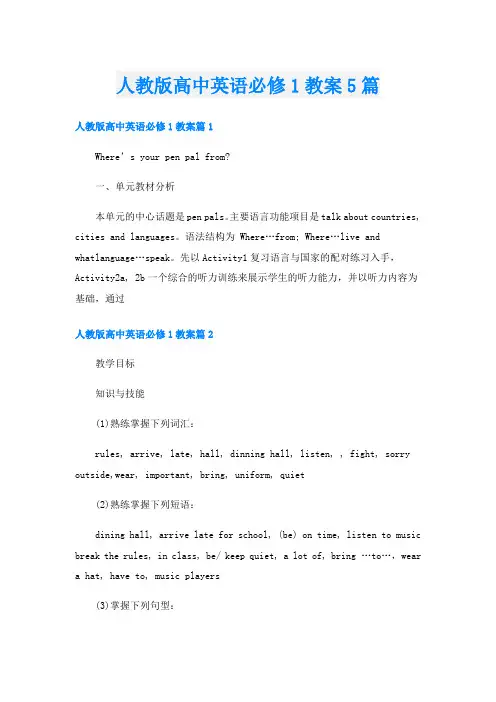
人教版高中英语必修1教案5篇人教版高中英语必修1教案篇1Where’s your pen pal from?一、单元教材分析本单元的中心话题是pen pals。
主要语言功能项目是talk about countries, cities and languages。
语法结构为 Where…from; Where…live and whatlanguage…speak。
先以Activity1复习语言与国家的配对练习入手,Activity2a, 2b一个综合的听力训练来展示学生的听力能力,并以听力内容为基础,通过人教版高中英语必修1教案篇2教学目标知识与技能(1)熟练掌握下列词汇:rules, arrive, late, hall, dinning hall, listen, , fight, sorry outside,wear, important, bring, uniform, quiet(2)熟练掌握下列短语:dining hall, arrive late for school, (be) on time, listen to music break the rules, in class, be/ keep quiet, a lot of, bring …to…,weara hat, have to, music players(3)掌握下列句型:1. Dont eat in class.2. You must be on time.3. Eat in the dining hall.4. 正确使用情态动词can, can’t——Can we wear a hat in school?——Yes, we can./No, we can’t.5. 能正确使用have to 和 must 谈论规章制度We must be on time/ We also have to be quiet in the library. 教学重难点重点:1) 肯定祈使句是省略掉主语的原形动词开头;2) 否定祈使句则是在肯定祈使句前加上“don’t”。
人教版高中英语必修一unit1教案最终版
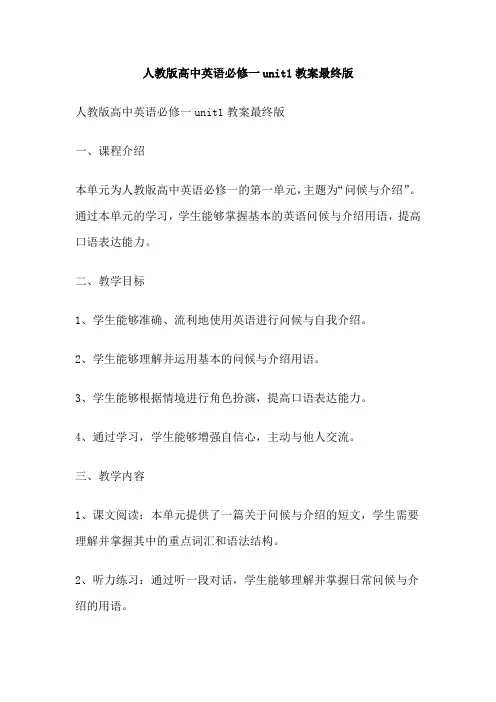
人教版高中英语必修一unit1教案最终版人教版高中英语必修一unit1教案最终版一、课程介绍本单元为人教版高中英语必修一的第一单元,主题为“问候与介绍”。
通过本单元的学习,学生能够掌握基本的英语问候与介绍用语,提高口语表达能力。
二、教学目标1、学生能够准确、流利地使用英语进行问候与自我介绍。
2、学生能够理解并运用基本的问候与介绍用语。
3、学生能够根据情境进行角色扮演,提高口语表达能力。
4、通过学习,学生能够增强自信心,主动与他人交流。
三、教学内容1、课文阅读:本单元提供了一篇关于问候与介绍的短文,学生需要理解并掌握其中的重点词汇和语法结构。
2、听力练习:通过听一段对话,学生能够理解并掌握日常问候与介绍的用语。
3、口语表达:学生需要进行多次口语练习,包括个人介绍、两人对话、小组讨论等,提高口语表达能力。
4、写作训练:学生需要写一篇关于自己或他人的介绍文章,巩固所学知识。
四、教学步骤1、导入新课:通过简单的问候,引导学生进入本单元的主题。
2、讲解新词:学习本单元的新单词,包括生词、词组和习惯用法。
3、课文阅读:阅读本单元提供的短文,并回答相关问题。
4、听力练习:听一段对话,并回答相关问题。
5、口语表达:进行多次口语练习,包括个人介绍、两人对话、小组讨论等。
6、写作训练:写一篇关于自己或他人的介绍文章。
7、复习巩固:回顾本单元所学内容,加深印象。
五、教学评价1、课堂提问:通过提问,检测学生对本单元重点内容的掌握情况。
2、小测验:进行小测验,检测学生对本单元重点词汇、语法和习惯用法的掌握情况。
3、课后作业:布置课后作业,让学生巩固本单元所学内容。
六、教学反思1、成功之处:通过多种教学方法的运用,本节课取得了良好的教学效果,学生积极参与,课堂氛围热烈。
2、不足之处:部分学生的口语表达能力还有待提高,需要加强针对性的训练。
3、改进措施:针对学生的不足,制定个性化的教学方案,加强针对性的训练,提高学生的口语表达能力。
高一英语必修一教案(优秀5篇)
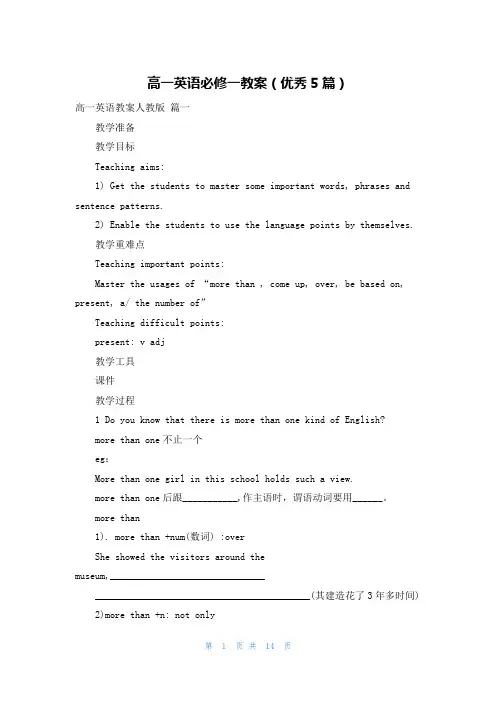
高一英语必修一教案(优秀5篇)高一英语教案人教版篇一教学准备教学目标Teaching aims:1) Get the students to master some important words, phrases and sentence patterns.2) Enable the students to use the language points by themselves.教学重难点Teaching important points:Master the usages of “more than , come up, over, be based on, present, a/ the number of”Teaching difficult points:present: v adj教学工具课件教学过程1 Do you know that there is more than one kind of English?more than one不止一个eg:More than one girl in this school holds such a view.more than one后跟___________,作主语时,谓语动词要用______。
more than1). more than +num(数词) :overShe showed the visitors around themuseum,__________________________________________________________________________(其建造花了3年多时间) 2)more than +n: not onlyMusic is more than just a sound--- it’s a way of thin king.3) more than +adj/v : very听到这个消息我很高兴。
新课标高一英语必修一全册教案
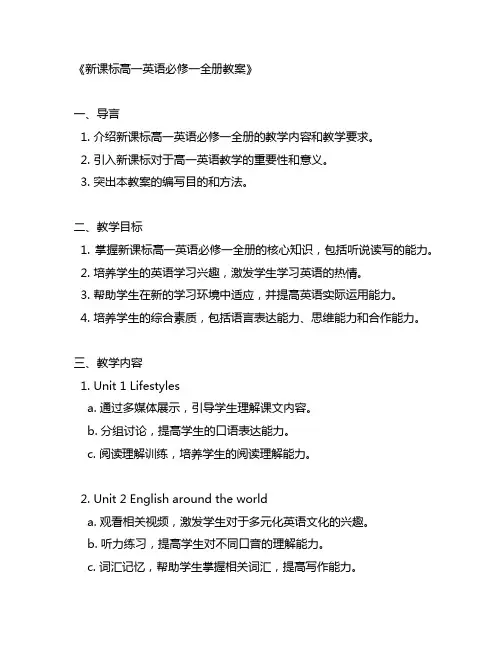
《新课标高一英语必修一全册教案》一、导言1. 介绍新课标高一英语必修一全册的教学内容和教学要求。
2. 引入新课标对于高一英语教学的重要性和意义。
3. 突出本教案的编写目的和方法。
二、教学目标1. 掌握新课标高一英语必修一全册的核心知识,包括听说读写的能力。
2. 培养学生的英语学习兴趣,激发学生学习英语的热情。
3. 帮助学生在新的学习环境中适应,并提高英语实际运用能力。
4. 培养学生的综合素质,包括语言表达能力、思维能力和合作能力。
三、教学内容1. Unit 1 Lifestylesa. 通过多媒体展示,引导学生理解课文内容。
b. 分组讨论,提高学生的口语表达能力。
c. 阅读理解训练,培养学生的阅读理解能力。
2. Unit 2 English around the worlda. 观看相关视频,激发学生对于多元化英语文化的兴趣。
b. 听力练习,提高学生对不同口音的理解能力。
c. 词汇记忆,帮助学生掌握相关词汇,提高写作能力。
3. Unit 3 Travel journala. 语法练习,巩固学生的语法知识。
b. 听力训练,提高学生的听力理解能力。
4. Unit 4 Wildlife protectiona. 观看相关纪录片,引导学生对于野生动物保护问题的思考。
b. 语言实践,激发学生表达观点的能力。
c. 课外阅读,拓展学生知识面,提高综合素质。
5. Unit 5 First aida. 观看教学视频,学习急救知识和技能。
b. 分角色扮演,培养学生的合作意识和团队精神。
c. 讨论交流,引导学生学会在紧急情况下正确表达和沟通。
6. Unit 6 Languagea. 语言点讲解,帮助学生理解和掌握语言的规则与用法。
b. 语言实践,激发学生运用所学语言进行交流。
7. Unit 7 The world of worka. 制定职业规划,帮助学生了解不同职业的本质和发展前景。
b. 个人陈述,提高学生的自我表达能力。
高一英语必修一unit1教案(优秀3篇)
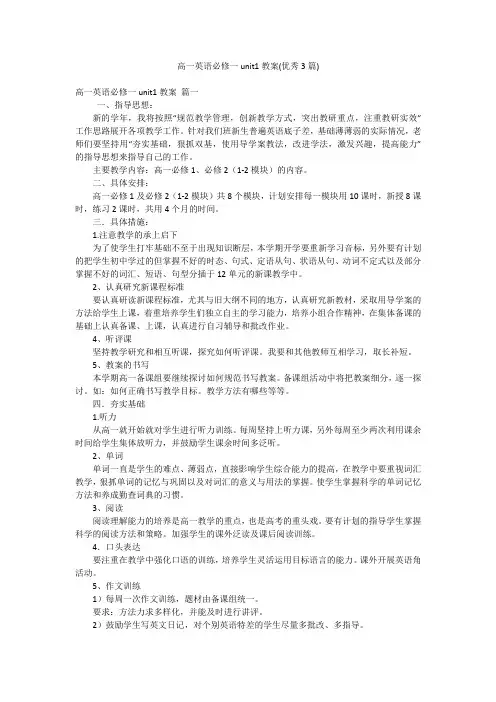
高一英语必修一unit1教案(优秀3篇)高一英语必修一unit1教案篇一一、指导思想:新的学年,我将按照“规范教学管理,创新教学方式,突出教研重点,注重教研实效”工作思路展开各项教学工作。
针对我们班新生普遍英语底子差,基础薄薄弱的实际情况,老师们要坚持用“夯实基础,狠抓双基,使用导学案教法,改进学法,激发兴趣,提高能力”的指导思想来指导自己的工作。
主要教学内容:高一必修1、必修2(1-2模块)的内容。
二、具体安排:高一必修1及必修2(1-2模块)共8个模块,计划安排每一模块用10课时,新授8课时,练习2课时,共用4个月的时间。
三.具体措施:1.注意教学的承上启下为了使学生打牢基础不至于出现知识断层,本学期开学要重新学习音标,另外要有计划的把学生初中学过的但掌握不好的时态、句式、定语从句、状语从句、动词不定式以及部分掌握不好的词汇、短语、句型分插于12单元的新课教学中。
2、认真研究新课程标准要认真研读新课程标准,尤其与旧大纲不同的地方,认真研究新教材,采取用导学案的方法给学生上课,着重培养学生们独立自主的学习能力,培养小组合作精神,在集体备课的基础上认真备课、上课,认真进行自习辅导和批改作业。
4、听评课坚持教学研究和相互听课,探究如何听评课。
我要和其他教师互相学习,取长补短。
5、教案的书写本学期高一备课组要继续探讨如何规范书写教案。
备课组活动中将把教案细分,逐一探讨。
如:如何正确书写教学目标。
教学方法有哪些等等。
四.夯实基础1.听力从高一就开始就对学生进行听力训练。
每周坚持上听力课,另外每周至少两次利用课余时间给学生集体放听力,并鼓励学生课余时间多泛听。
2、单词单词一直是学生的难点、薄弱点,直接影响学生综合能力的提高,在教学中要重视词汇教学,狠抓单词的记忆与巩固以及对词汇的意义与用法的掌握。
使学生掌握科学的单词记忆方法和养成勤查词典的习惯。
3、阅读阅读理解能力的培养是高一教学的重点,也是高考的重头戏。
高一英语必修一第一单元教案
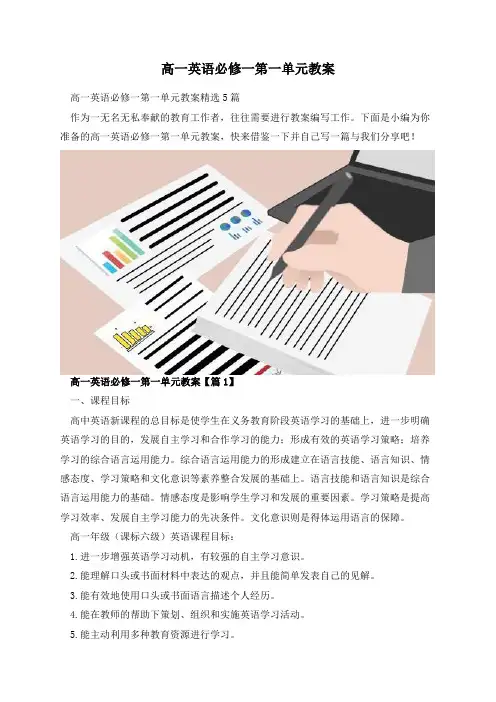
高一英语必修一第一单元教案高一英语必修一第一单元教案精选5篇作为一无名无私奉献的教育工作者,往往需要进行教案编写工作。
下面是小编为你准备的高一英语必修一第一单元教案,快来借鉴一下并自己写一篇与我们分享吧!高一英语必修一第一单元教案【篇1】一、课程目标高中英语新课程的总目标是使学生在义务教育阶段英语学习的基础上,进一步明确英语学习的目的,发展自主学习和合作学习的能力;形成有效的英语学习策略;培养学习的综合语言运用能力。
综合语言运用能力的形成建立在语言技能、语言知识、情感态度、学习策略和文化意识等素养整合发展的基础上。
语言技能和语言知识是综合语言运用能力的基础。
情感态度是影响学生学习和发展的重要因素。
学习策略是提高学习效率、发展自主学习能力的先决条件。
文化意识则是得体运用语言的保障。
高一年级(课标六级)英语课程目标:1.进一步增强英语学习动机,有较强的自主学习意识。
2.能理解口头或书面材料中表达的观点,并且能简单发表自己的见解。
3.能有效地使用口头或书面语言描述个人经历。
4.能在教师的帮助下策划、组织和实施英语学习活动。
5.能主动利用多种教育资源进行学习。
6.能初步对学习过程和结果进行自我评价,调整自己学习目标和策略。
7.能体会交际中所使用语言的文化内涵和背景。
高一年级(课标七级)英语课程目标:1.有明确和持续的学习动机和自主学习意识。
2.能就熟悉的话题交流信息,提出问题并且陈述自己的意见和建议。
3.能读懂供高中学生阅读的英文原著简写本及英语报刊。
4.具有初步的实用写作能力,例如:事务通知和邀请信等。
5.能在教师的指导下,主动参与计划、组织和实施语言实践活动。
6.能主动扩展和利用学习资源,从多渠道获取信息,并能利用所获得的信息进行清楚和有条理的表达。
7.具有较强的自我评价和自我调控能力,基本形成适合自己的学习策略。
8.理解交际中的文化差异,初步形成跨文化交际意识。
二、课程内容完成牛津英语第三第四模块的全部内容。
高一英语必修一unit1教案
高一英语必修一unit1教案高一英语必修一unit1教案「篇一」(1)课题:Earthquakes(2)教材分析与学生分析:本单元的主题是“地震”。
Warming Up部分Pre-Reading部分要求学生描述、讨论与地震有关的话题。
Reading部分是一篇新闻报道,介绍了唐山大地震前的预兆、地震造成的城市建筑和人畜损失以及地震后的救援情况。
Learning about Language部分涉及了本单元的词汇和语法。
该部分主要通过阅读和句型练习帮助学生学习单词、数字的表达法以及有that, which, who, whose引导的定语从句,培养学生的自主学习能力。
Using Language部分的“读写说(Reading, writing and speaking)”训练提供了一封信,要求学生阅读后写一篇大地震纪念公园落成仪式上的演讲稿,接着说一说唐山大地震纪念邮票。
随后的听力(Listening)是一位美国人以第一人称叙述他在1906年旧金山大地震中的可怕经历。
写作(Writing)部分训练学生如何写新闻报道,学会拟地定写作提纲。
(3)课时安排:The first period: Reading The second period: ReadingThe third period: Listening The forth Period:Grammar The fifth period: Extensive reading The sixth period: Summary (4)教学目标:①知识与技能:了解地震的成因、预兆,地震造成的损失,地震时的应急措施以及震后的救援;掌握和运用本单元出现的新词汇和短语以及数字的表达法;熟练运用that, which, who, whose引导的定语从句;学会写英文新闻报道,拟订写作提纲。
②过程与方法:在学习阅读部分时,可以根据教学的需要和教学班级的实际,从不同的角度设计目的明确的任务。
高一必修一英语教案(精选4篇)
高一必修一英语教案(精选4篇)高一必修一英语教案(精选4篇)教案中对每个课题或每个课时的教学内容,教学步骤的安排,教学方法的选择,板书设计,教具或现代化教学手段的应用,各个教学步骤教学环节的时间分配等等,下面是为大家整理的关于高一必修一英语教案,欢迎大家阅读参考学习!高一必修一英语教案(篇1)一、教学背景分析1. 单元背景分析随着科学技术的发展,各种各样新的发明和发现都层出不穷。
生活在这样一个知识爆炸的年代,学生们更应用心去体会并感受科技和发明创造者给生活带来的变化,进而能联想到他们平时所学的学科及知识,并用英语为媒介进行知识的整合与串联。
同时从另一个角度来说,科技进步的同时,我们的社会也产生了各种各样的矛盾与争论,因此如何正确的看待或处理这些问题,也成为广大学生应该了解并掌握的知识。
2.学生情况分析本单元的设计与实施是建立在学生经过高一上半学期新教材学习基础之上。
学生已经逐步的适应了在活动与任务中学习英语以及如何处理语言知识与活动开展的关系。
并且,他们也已经形成并培养了一定的小组合作学习及自主学习的能力。
二、教学目标分析语言技能听:在听懂教师向学生讲述实验中注意事项基础上,继续学习并强化捕捉特定信息的能力,以及确定全文主要话题的概括能力。
说:应能在了解一定的现代科技发明基础上,思考并学习如何对一种新的事物进行描述。
同时能与他人进行交流,叙述事物的利与弊端。
读:强化略读、查读等阅读微技能,训练通过寻找关键词,主题句等方式更快速并准确的确定*的段落大意,理清*的总体框架与脉络。
继续运用已经掌握的基本猜词技巧猜测部分单词,并在上下文体验中感受某些佳句给读者带来的深层含义。
写:学习在对事物进行理性思考的基础上,运用恰当的句型与词汇描述对事物正反面的不同观点,同时更应注重掌握一些必要的过渡词增加此类写作的条理性与层次感,并应熟悉议论性作文的基本写作框架。
情感态度与文化意识(1)。
进一步培养小组合作学习的能力,通过调查、采访、讨论等活动完成任务,取长补短,加强团体协作意识。
人教版高中英语必修一全套教案
Unit 2 English Around the WorldI Teaching aims1.Knowledge aim2.Master the words and phrases and get a view of the road to modern English.3.Ability aim4.Train students’ reading skill.5.Emotion aim6.Let students know more about English and inspire students to study English hard. IITeaching important pointsThe understanding and comprehension of the passage.III Teaching difficult pointHow to get to master the useful words and expressions.How to improve students’ ability to read an article.IV Teaching ProceduresV Teaching TimeSeven Periods.Period 1 Warming up and ReadingStep1. Warming up1. Lead in: Show Ss a map of the world, and ask them the following questions:1) How many languages are there in the world?2) How many English-speaking counties are there in the world?3) How are you ever heard some differences between American English and BritishEnglish?Step2. Reading(1)SkimmingRead the passage quickly and find out the answers of the questions in comprehension.(2)Scanning(3)Listen to the tape and tell the meaning of each paragraph.1. Para1: Brief introduction of the change in English.2. Para.2: An example of different kinds of English.3. Para3: The development of English.Para4: English spoken in some other countries.(4)Post readingStep3. DiscussionSome people say that Chinese is a much more elegant language, so it is more important for us to master it and it is not so necessary to master foreign language. Do you agree with this opinion and why?Period 2 Language pointsLanguage points:1. Do you know that there is more than one kind of English in the world?你知道世界上英语的种类并不止一种吗?more than one +名词单数,后面的谓语动词用单数例如:More than one student wants to go to swim.2.In some important ways they are very different form one another.在某些重要的方面,它们彼此有些差异。
高中英语新课标人教版教案必修一
高中英语新课标人教版教案必修一一、教学内容本节课选自高中英语新课标人教版必修一,具体章节为Unit 1 "My First Day at Senior High"。
教学内容主要包括:了解并描述学生在高中第一天的生活和感受;学会使用一般过去时描述过去的事件;掌握本节课的核心词汇和短语。
二、教学目标1. 能够听懂并准确说出与高中生活相关的词汇和短语。
2. 能够运用一般过去时描述过去的事件,提高语言运用能力。
3. 能够通过小组合作,交流并分享自己在高中第一天的经历和感受。
三、教学难点与重点1. 教学难点:一般过去时的运用,特别是动词过去式的变化规则。
2. 教学重点:核心词汇和短语的掌握,以及运用一般过去时进行简单的叙述。
四、教具与学具准备1. 教具:多媒体教学设备、黑板、粉笔、单词卡片。
2. 学具:英语课本、笔记本、字典。
五、教学过程1. 导入:通过播放一段关于高中生活的视频,引导学生关注本节课的主题。
2. 新课内容展示:展示本节课的核心词汇和短语,让学生跟读并模仿。
3. 例题讲解:以"Yesterday was my first day at senior high. I"为例,讲解一般过去时的用法。
4. 随堂练习:让学生运用一般过去时,描述自己在高中第一天的经历。
5. 小组活动:学生分成小组,互相交流并分享自己的经历,提高语言表达能力。
六、板书设计1. 核心词汇和短语:写在黑板的左边,方便学生查看。
2. 一般过去时的结构:写在黑板的右边,突出教学重点。
七、作业设计1. 作业题目:请用一般过去时描述你昨天的一天。
2. 答案示例:Yesterday was my busy day. I got up at 6:00, had breakfast and went to school. In the morning, I had four classes. After lunch, I played basketball with my friends. In the evening, I did my homework and watched TV.八、课后反思及拓展延伸1. 课后反思:本节课学生对于一般过去时的掌握程度较好,但仍有个别学生动词过去式变化不准确,需加强练习。
- 1、下载文档前请自行甄别文档内容的完整性,平台不提供额外的编辑、内容补充、找答案等附加服务。
- 2、"仅部分预览"的文档,不可在线预览部分如存在完整性等问题,可反馈申请退款(可完整预览的文档不适用该条件!)。
- 3、如文档侵犯您的权益,请联系客服反馈,我们会尽快为您处理(人工客服工作时间:9:00-18:30)。
高中英语必修一教案Unit 1 Friendship1.Teaching aims and demands类别课程标准要求掌握的项目话题Friends and friendship; interpersonal relationships词汇add point upset ignore calm concern loose cheat reason list share feeling Netherlands German outdoors crazy nature purpose dare thunder entirely power according trust indoors suffer teenager advice questionnaire quiz situation editor communicate habitadd up calm down have got to be concerned about walk the dog go through hide away set down a series of on purposein order to face to face according to get along with fall in lovejoin in功能态度(attitudes)Are you afraid that---?I’ve grown so crazy about---I didn’t dare---2. 同意和不同意(agreement and disagreement)I agree. I think so. Exactly.I don’t agree. I don’t think so. I’m afraid not.3.肯定程度(certainty)That’s correct. Of course not.1.Suggested teaching notes1). Analyses of the teaching contentsThis unit is about friendship, and nearly all the teaching materials center on it. Warming up---The questionnaire leads students to think and talk aboutfriendship, get to know the problems between friendsand seek solutions, which makes preparations for thefurther teaching in topics, background and vocabulary. Pre-reading---The questions prompt students to think critically aboutfriends and friendship in reality, alerting them to the factthat besides people, a diary can be a friend, too.Reading--- The diary by the Jewish girl Anne gave a glimpse of her lifeduring her family’s shelter in Amsterdam from the GermanNazis’ killing in world war 2. she treats the diary as her best friend, and init reveals her longing for a normal life and close contact with nature,which helps her get through the days.Comprehending---It helps students further understand the text by doingmultiple choices, questions and answers, andmatching.Learning about language---It teaches the important expressions andstructures and grammar: direct and indirectspeeches.Using language---The two letters, listening, questionnaire design, letterwriting and fun writing prepares students to furthertalk about friendship, especially the problems withmisunderstanding, and unfriendliness, thusstrengthening students’ abilities to practicelanguage, discover, and solve problems.Summing up---It summarizes the whole contents of this unit from theaspects of topics, vocabulary and grammar.Learning tip--- This part encourages students to form the habit of writinga diary.Integrating skills--- The text introduces the way Hawaiians expressfriendship, to get students to realize the culturaldifferences in the values of friendship in additionits importance in all cultures.2) Making of the teaching planThis unit centers on friends and friendship, exploring different types of friendship with particular attention to that one can develop with oneself, i.e., the comfort and support one seeks from an imaginary friend. Students are expected to come to be truly aware of the qualities and conducts that make a good friend, display and develop the ability to cope with misunderstanding, conflicts and problems related to friendship, and give advice on it. The concept that even an ordinary thing can be a friend should break down the traditional belief in the interpersonal nature of friendship. Also, the comparison of similarities dissimilarities in friendship comprehension between the East and the West leads students to know better the values of friendship in Westerns’ eyes. All in all, this unit promises to unveil the true essence of friendship and helps students to lead a more friendly and harmonious life. Thus, based on the theme, contents and teaching objectives, the whole teaching procedures can fall into five periods as follows:3. Teaching plans for each periodPeriod 1 Warming-up and Speaking1. Teaching objectives:1) Target languageI (don’t) think…… I (don’t) think so. I (don’t) agree.I believe…… That’s correct. In my opinion, ……2) Ability goalsa.Describe your friends in Englishb.Figure out the problems between friends and then find different ways to solve theproblems.3)Learning ability goalsa.To encourage students to think and talk about friends and friendship by using somephrases and structures.b.To learn to solve problems that may occur between friends.c. To cultivate the students to form the good habit of learning English in SeniorMiddle School.2. Teaching important points:e the given adjectives and sentence structures to describe one of yourfriends.b.Learn to evaluate friends and friendship.3. Teaching difficult points:a.Work together with partners and describe one of your good friends.b.Discuss with partners and find out ways to solve the problems.4. Teaching methodsa.Task-based teaching and learningb.Cooperative learningc.Discussion5. Teaching aids:CAI6. Teaching procedures and ways:Step 1 Lead-in and Warming-upBefore the lesson, the te acher can arouse the students’ interests by showing a video of Auld Lang Syne .At the beginning of the first class, we can get the students to talk about their summer holidays. The students can talk freely as they like.1.How did you spend your summer holidays? How did you feel? What didyou do in your summer holidays? What did you do in your spare time?2.What do you think of our new school? Do you like it? Could you saysomething about it?3.Do you like making friends? How do get in touch with your friends? Doyou have many friends? Where are they now? Do you have any oldfriends in our school? Have you made any new friends in our class?Step 2 Think it over1. Give a brief description of one of your friends. The following phrases andstructures may be helpful:His/Her name is ……He /She is …… years old.He /She likes …… and dislikes ……He /She enjoys …… and hates……He /She is very kind/friendly/……When /Where we got to know each other.2. What types of friendship do you have? Please tick them out. Then fill in theblanks.girl friends boy friends pen friendslong -distance friends friends of the same agee-friends (friends over the internet) friends across generationsunusual friends like animals, books……1).______ is /are most important to you.2). You spend most of your free time with ____.3). You will share your secrets with _____.4). When in trouble, you will first turn to _____.Step 3 Make a survey1. List some qualities of a good friend or your ideal friend. Have the students get into groups of four to find out what each has listed.Tell your partner your standards of good friends by using the following structure:I think a good friend should (not) be……In my opinion, a good friend is someone who……1.Have a member of each group report on what their lists have in common and listthem on the board.2.Ask the class whether or not they agree with all the qualities listed.3.Then have the students do the survey in the textbook.4.Have the students score their survey according to the scoring sheet on page 8.5.The teacher ask some students how many points they got for the survey and assesstheir values of friendship:Step 4 Talking and sharing( work in pairs)1. If your best friend does something wrong, what will you do?Try to use the following phrases:I (don’t) think…… I (don’t) think so.I (don’t) agree. I believe……That’s correct. In my opinion, ……2. What is a friend?A British newspaper once offered a prize for the best definition(定义) of a friend. Ifyou were the editor, choose the best one from the following entries(条目), and explain why.One who understands my silence.A friend in need is a friend indeed.Friends are just the people who share your happiness and sorrow. When you look at your watch at 4 am, but still know you can call them and wake them up, and they’ll still want to talk to you ,that’s friendship. To have a friend, you need to be a good friend.Step 5 Group work (output)The teacher can give each group one of these questions below to talk about. Then let the class share their ideas. It’s better to stimulate the students to express their own opinions about these questions.1.Do you think it is a good idea to borrow money from your friend?Why and Why not?2. What factors may cause the breakdown of a good friendship?3. What can be your unusual friend besides human beings? And why?Step 6 Homework1.Write down a short passage about your ideas /the factors/your unusual friends.2.Prepare for the new lesson.Period 2 Reading “Anne’s Best Friend”1. Teaching objectives:1) To develop the students’ reading ability, learn to use some reading strategies suchas guessing, key sentences, skimming and so on;2). To get the students to realize the importance of friends and friendship, and to telltrue friends from false friends;3). To grasp some useful words and expressions in this passage, such as on purpose,be crazy about etc.;4). To learn the writing style of this passage.2. Teaching method: Task-based teaching3). Teaching procedure:Step 1.Pre-reading1. Please enjoy three pieces of music and find out what they are about.2 .Why do you think friends are important to you?3. What do you think a good friend should be like? List the good qualities a goodfriend should have .4. Have you ever considered making friends with animals, plants or even an object?Why or why not?Step 2.Reading1. Try to guess what Anne’s friend is and what the passage is about by reading thetitle and having a quick at the pictures in this passage without reading it.2. Skimming the first two paragraphs to confirm your guessing.1) What was Anne’s best friend? Why did she make friends with it?2) Did she have any other true friends then? Why?3) What is th e difference between Anne’s diary and those of most people?4) Do you keep a diary? What do you think most people set down in their diaries?5) We are going to read one of Anne’s diaries .but before reading ,can you tell me what the diary is about with the help of one key sentence in the 2nd paragraph?3. Reading of Anne’s diaryHow she felt in the hiding placeTwo examples to show her feelings thenStep 3.Post-reading1.What would you miss most if you went into hiding like Anne and her family?Give your reasons.2.Group workWork in groups to decide what you would do if your family were going to be killed just because they did something the Emperor did not like.Where would you plan to hide?How would you arrange to get food given to you every day?What would you do to pass the time?------3. Discovering useful words and expressionsStep 4.Talking about friends and friendship1.There are many proverbs about friends and friendship. Choose the one you agreewith and explain why, then choose one you disagree with and explain why.2. We have talked about friends and friendship today, can you write one or twosentences to express your understanding of friends and friendship.Step 5.Homework:1. Interview a high school student, a businessman, a police officer and a housewifeto find out their opinions about friends and friendship. Write a report to share it with the whole class.2. Describe one of your best friends following the writing style of this passage.Ending: Let’s sing this song about frien ds togetherPeriod 3 Grammar1.Teaching objectivesLearn to use direct speech and indirect speech2. Teaching important pointSummarize the rules of Direct Speech and Indirect Speech.3. Teaching difficult pointLearn about the special cases in which th e tenses shouldn’t be changed.4. Teaching methodsDiscussing, summarizing and practicing.5.Teaching proceduresStep1 Lead inT: In the last lesson, we learned Anne Frank’s story. She is telling her stories to two of her friends—you and Tom. Tom has something wrong with his ears, so you have to repeat Anne’s sentences, using indirect speech. Sometimes you explain Tom’s sentences to Anne.“I have to stay in the hiding place.” said Anne. →Anne said she had to stay in the hiding place.“Do you feel sad when you are not able to go outdoors?” Tom asked Anne. →Tom asked Anne if/whether she felt sad when she was not able to go outdoors.“I don’t want to set down a series of facts in a diary,” said Anne.→Anne said that she didn’t want to set down a series of fact s in a diary.“What do you call your diary?” Tom asked. →Tom asked what she called her diary.Ss go on this topic by themselves.Step2 GrammarT: Now let’s look at these sentences again. If we want to change Direct Speech into Indirect Speech, what should be changed?Ss discuss by themselves.Ss: sentence structures, tenses, pronouns, adverbials of time and place and verbs should be changed.T: Quite right. Look at the form on the screen. These are the rules...Step3 practice1.T: Turn to Page 5. Please change the following direct speech into indirect speechand indirect into direct...Step4 Correcting mistakesT analyses the common mistakes Ss have made during the practice.T: Now let’s look at the screen and pay attention to these sentences. Choose the right sentence and tell me why the other one is wrong.Step5 A gamePlay a guessing game “who is my secret friend?” One student comes to the front with his partner.The rest students ask him questions while his partner changes them into indirect speech. In the end, the person who has guessed the right answer can come to the front to take the place of the first student .So the game goes on.Suggested sentences:Can your friend speak?What does he/she wear today?Is he/she tall or short?What do you and your friend do in your free time?Do you quarrel with each other?...Step6 HomeworkDo Exercise1 on Page 42. Here is another page of Anne’s diary. Read it through and then use indirect speech to retell the story.Period 4 Integrating skills“Friendship in Hawaii”1. Teaching objectives:To learn about ways of showing friendship in Hawaii and share their opinions on friendship. Because it is a lesson of integrating skills, Ss are also asked to write sentences on friendship.2. Teaching procedures:Step1 Lead-in1. Talk about different ways of showing friendship of minority groups in China.2. Compare Chinese ways of showing friendship with Western ways. And discusswhy there is a big difference. Therefore, show the sentence: Every culture has itsown ways to show friendship.3. Ask students if they can think of any place in the world where Chinese andWestern cultures live side by side. They may think of Hongkong, Macao, Singapore.And the teacher will add one more -------Hawaii.Step2 Fast reading1. It is said that Hawaii is a place where the East truly meets the west. Consider howpeople show their friendship in Hawaii.Show a picture and find the information from the textbook. ( by giving “leis” to one another.)Explain what is a “lei”.2. Read fast and find out more ways to show friendship in Hawaii to fill in the form.3. According to the form, ask them to consider what friendship is in Hawaiians.Step 3 Careful reading1.Read the 2nd paragraph carefully and ask “Why do many different peoples callHawaii their home?”( Hawaii is a place where people make one big community from many smaller communities. It means Hawaii has a rich cultural diversity.)Step 4 Writing task1.Show proverbs about friends and friendship. Explain them and ask Ss to choosesome they agree with and some they disagree with and explain why.2.Discuss with their partner and try to write some similar sentences to show theiropinions on friendship.Step 5 HomeworkSurf the Internet to collect materials like poems, stories about friendship. And share them with your friends.Period 5 Listening & Writing1. Teaching objectivesTo practise students’ listening ability.To practise students’ writing skills of how to offer advice.To improve students’ ability to help othe rs solve problems.2. Teaching procedure(Analysis: Listening and writing are expansion of the topic of the text. Listening is about Lisa’s problem of making a friend with a boy. She asks Miss Wang for advice. Through listening and exercise, students learn how to give advice and the skill of giving advice. And also let them think about the problem of boy’s making friends with girls and girls with boys. And then design a task to ask students to give advice according to the different problems to practise their ability to solve the problems. All of these lay the foundation for the next task writing. In this way, students feel that they have information to put out. And writing makes for the improvement of students’ writing ability, strengthening their comprehension of friendship.)Step 1 Lead-inDo you remember what Ann’s best friend is?Is it a man or a thing?Have you seen the film Cast Away?When Tom is alone on a deserted island, what does he make friends with? ( a volleyball)Guess what my best friend is? (Say sth. about music, pets or plants.)So you see a man can make friends with anyone and anything.Then boys, would you like to make friends with girls? Girls, would you like to make friends with boys?What kind of girl would you like to make friends with? And what kind of boy would you like to make friends with?If you see a boy classmate makes a friend with a girl, will you say something aboutthem behind?(If no, say you are kind. If yes, say you are a gossiper.)If you are that boy/girl, would you like to be gossiped about?But here Lisa has such a problem. Read the letter. Lisa is asking you for help. What advice will you give? You are given 2 minutes to discuss in groups and then offer group’s opinions.Step 2 ListeningBesides you Lisa also asks Miss Wang of Radio for Teenagers for help. What advice does Miss Wang give to Lisa? Let’s listen to what she says.Listen for 3 times and do listening exercises.Step 3 Post-listeningDo you think Miss Wang’s advice is helpful?Now suppose you are editors of Radio for Teenagers, here are some problems for you to offer advice.(Give each group a problem and ask them to write down their advice.)1.I don’t have enough pocket money.2.I’m not satisfied with my appearance.3.My desk mate has lost a reference book, she/he thinks that I’m a thief.4.I work hard but I hardly make progress.5.I want to travel to WuZhen Town with my fiends this weekend, but my parents don’tallow me to go.6.I don’t like the way Mr. Li teaches us English, so I’m not interested in English anylonger.7.My mother has just given birth to my little brother. I’m worried that the baby willrob me of my parents’ love and even everything.8.I quarreled with my best friend 3 days ago. Up to now, we haven’t said a word toeach other.9.I’d like to be monitor, but at the same time I doubt whether I have such ability.10.I’m often late for school. The teacher is so angry that he threatens that if I’m lateagain, I will be dismissed.Step 4 WritingYour advice is good and helpful. All of you are qualified editors. Now I have just received a letter from a lonely boy. Read the letter, what is his problem? What is your advice for him? Write a reply.Step 5 HomeworkWrite a story about you and your friend.Unit 2 English Around the WorldⅠ单元教学目标技能目标GoalsTalk about English and its development, Different kinds of EnglishTalk about difficulties in language communicationLearn to make dialogue using request & commandsLearn to transfer from direct into indirect speechLearn to give opinions and organize ideas by way of brainstormingLearn to make a poster showing your ideas clearlyⅡ目标语言功能句式Talk about English and its developmentRefer to Introduction in the teachers’ bookTalk about difficulties in language communicationDifferent speaker may come from different place, so they may use different words and dialect, such as subway-underground、left-left-hand-side 、two blocks two streets.Make dialogues using request or command:Pardon? Could you repeat that, please?I beg your pardon? Can you speak more slowly, please?I don’t understand. Sorry. I can’t follow you.Could you say that again, please? How do you spell it, please?词汇1.四会词汇include role international native elevator flat apartment rubber petrol gas modern culture AD actually present(adj.) rule(v.) vocabulary usage identity government Singapore Malaysia rapidly phrase candy lorry command request retell polite boss standard mid-western southern Spanish eastern northern recognize accent lightning direction ma’am subway block2. 认读词汇Shakespeare Noah Webster Lori dialect Houston Texas Buford Lester catfish3. 固定词组play a role (in) because of come up such as play a part (in)语法Command & requestOpen the door. Please open the door.Would you please open the door?Indirect SpeechHe told (asked) me to open the door.Ⅲ.教材分析和教材重组:1. 教材分析本单元的中心话题是“English language and its development, different kinds of English”. 通过对世界英语这一话题的探讨,加强学生对英语语言的了解,对当代语言特别是英语发展趋势的了解.世界在发展,时代在前进,语言作为交流的工具,也随着时代的发展而变化.由于英语在世界上的广泛使用,它不断地吸收、交融、容纳、创新,这就形成了各种各样带有国家、民族、地区特色的英语. 没有人们认为的那种唯一的标准英语。
